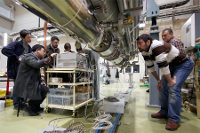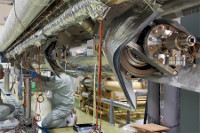 |
 |
|||||||||||||
|
|||||||||||||
|
|||||||||||||
|
Following the successful cavity string work for superconducting acceleration cavities from Europe and Americas, a team of four scientists and engineers form INFN, Italy and Fermilab, US, arrived in Japan for the assembly work of the frequency tuners for S1-global work. The voltage of the field changes with a certain frequency: a radio frequency (RF). For effective acceleration of charged particles in the superconducting acceleration cavity, controlling the RF resonance frequency in the cavity is crucial. When energy pulse is supplied into the cavity to establish the accelerating field, the cavity will be deformed by electromagnetic force called Maxwell stresses or Lorentz Force, and the value of RF resonance frequency changes. Because cavities are operated under the superconducting state at 2K (-271°C), the width of the RF resonance becomes very small. Therefore, the change of the RF resonance frequency caused by cavity deforming will have great influence on the efficiency of acceleration. To deal with this issue with stabilising the RF resonance frequency, the tuning system plays an important role. A series of assembly works done in the week of 8 February was for the Cryomodule-C, one of two cryomodules used for S1-global experiment. “It was a really good collaboration,” said Carlo Pagani from the University of Milano and INFN, who leads the team of four: Angelo Bosotti and Rocco Pararella from INFN, and Serena Barbanotti who transferred to Fermilab six months ago from his group at INFN Milano-LASA, so they all know each other very well. “We had some minor problems, but we were so confident that we could fix those.” Carlo Pagani, who was the Project Leader for TESLA at the time of the ILC technology choice, has been in the superconducting acceleration business for long time, but the Italian team is not really focused too much on the ILC project. “We are now on a more 'real' project of European XFEL, using the same superconducting technology. So, we are a little far away,“ said Pagani. “I know this business very well and it is complicated. Even though it looks similar, there is difference in the detail. I came here because I wanted to see if we can really put different components together. Another reason is that I wanted to have a chance to work with my old friends again. I know generations of KEK scientists very well, and I have good friends here,” he smiled. They have started their assembling job on the four-string dressed cavities, which have been equipped with the liquid helium pipe by KEK after the visit of European and American scientists and engineers. In their four days' job, including Japanese holiday of National Foundation Day, they finished to place the super insulators and magnetic shields with two different types of tuners: the "Saclay tuner" and the INFN blade-tuner, another example of verifying the plug compatibility of this global effort. Tuning is made when the cavity is at cryogenic temperature by changing its length in order to exactly put the sharp resonance curve at the nominal frequency of 1.3 Gigahertz. The Saclay tuner is the tuner designed and developed at CEA/Irfu in Saclay, France. They have been developing the tuning systems for decades and the one used for S1-global is using the principle of the Super-3HC tuner with three fixations on the helium tank. It is the same series of the tuners employed for the European XFEL project. The Saclay tuners are attached on two European cavities Z109 and Z108. The INFN Blade-Tuner used for S1-global is a contribution from INFN who has developed this concept since 1999 for the superstructure experiment at DESY in view of TESLA. Through improvements and simplifications for cost reduction the coaxial blade-tuner was one of the reference designs for TESLA and has been used for the ILC costing exercise satisfying the ILC-level performance and cost requirements. The working principle for the blade-tuner is to transfer the azimuthal rotation of a ring element provided by a stepper motor in a change of cavity length via elastic deformation of titanium blades. They are attached to two American cavities, ACC011 and AES004. After the successful operation check of all four tuners in a room-temperature environment, the bottom halves of the magnetic shields were applied, and the assembly team from Italy and Americas completed their work at KEK. The assembly work on Cryomodule C is continuing by KEK staff, in parallel with the assembly work for another cryomodule, Cryomodule A with four Japanese cavities. The detail of this activity will be reported in future issues of ILC NewsLine. -- Rika Takahashi |
|||||||||||||
| © International Linear Collider |

